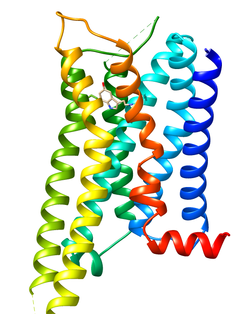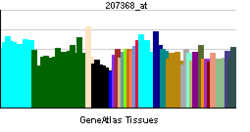5-HT1D receptor
Prijeđi na navigaciju
Prijeđi na pretragu
| edit |
| 5-hidroksitriptaminski (serotoninski) receptor 1D | |||||||||||
|---|---|---|---|---|---|---|---|---|---|---|---|
 | |||||||||||
| Identifikatori | |||||||||||
| Simboli | HTR1D; 5-HT1D; HT1DA; HTR1DA; HTRL; RDC4 | ||||||||||
| Vanjski ID | OMIM: 182133 MGI: 96276 HomoloGene: 20240 IUPHAR: 5-HT1D GeneCards: HTR1D Gene | ||||||||||
| |||||||||||
| Pregled RNK izražavanja | |||||||||||
 | |||||||||||
| podaci | |||||||||||
| Ortolozi | |||||||||||
| Vrsta | Čovek | Miš | |||||||||
| Entrez | 3352 | 15552 | |||||||||
| Ensembl | ENSG00000179546 | ENSMUSG00000070687 | |||||||||
| UniProt | P28221 | Q3ZB48 | |||||||||
| RefSeq (mRNA) | NM_000864 | NM_008309 | |||||||||
| RefSeq (protein) | NP_000855 | NP_032335 | |||||||||
| Lokacija (UCSC) | Chr 1: 23.39 - 23.39 Mb | Chr 4: 135.7 - 135.72 Mb | |||||||||
| PubMed pretraga | [1] | [2] | |||||||||
5-HT1D receptor (5-hidroksitriptaminski (serotoninski) receptor 1D, HTR1D) je 5-HT receptor. On je kodiran istoimenim genom.[1] 5-HT1D deluje na centralni nervni sistem, i utiče na kretanje i anksioznost. On takoše indukuje vaskularnu vazokonstrikciju u mozgu.
Ligandi[uredi | uredi kod]
Agonisti[uredi | uredi kod]
2
Vidi još[uredi | uredi kod]
Literatura[uredi | uredi kod]
- ↑ „Entrez Gene: HTR1D 5-hydroxytryptamine (serotonin) receptor 1D”.
- ↑ Glennon RA, Hong SS, Dukat M, Teitler M, Davis K (1994). „5-(Nonyloxy)tryptamine: a novel high-affinity 5-HT1D beta serotonin receptor agonist”. J. Med. Chem. 37 (18): 2828–30. DOI:10.1021/jm00044a001. PMID 8071931.
- ↑ Xu, YC; Schaus, JM; Walker, C; Krushinski, J; Adham, N; Zgombick, JM; Liang, SX; Kohlman, DT i dr.. (1999). „N-Methyl-5-tert-butyltryptamine: A novel, highly potent 5-HT1D receptor agonist.”. Journal of medicinal chemistry 42 (3): 526–31. DOI:10.1021/jm9805945. PMID 9986723.
- ↑ „Essential psychopharmacology: neuroscientific basis and practical applications”.
Dodatna literatura[uredi | uredi kod]
- Hamblin MW, Metcalf MA, McGuffin RW, Karpells S (1992). „Molecular cloning and functional characterization of a human 5-HT1B serotonin receptor: a homologue of the rat 5-HT1B receptor with 5-HT1D-like pharmacological specificity.”. Biochem. Biophys. Res. Commun. 184 (2): 752–9. DOI:10.1016/0006-291X(92)90654-4. PMID 1315531.
- Weinshank RL, Zgombick JM, Macchi MJ, et al. (1992). „Human serotonin 1D receptor is encoded by a subfamily of two distinct genes: 5-HT1D alpha and 5-HT1D beta.”. Proc. Natl. Acad. Sci. U.S.A. 89 (8): 3630–4. DOI:10.1073/pnas.89.8.3630. PMC 48922. PMID 1565658.
- Hamblin MW, Metcalf MA (1991). „Primary structure and functional characterization of a human 5-HT1D-type serotonin receptor.”. Mol. Pharmacol. 40 (2): 143–8. PMID 1652050.
- Libert F, Passage E, Parmentier M, et al. (1992). „Chromosomal mapping of A1 and A2 adenosine receptors, VIP receptor, and a new subtype of serotonin receptor.”. Genomics 11 (1): 225–7. DOI:10.1016/0888-7543(91)90125-X. PMID 1662665.
- Libert F, Parmentier M, Lefort A, et al. (1989). „Selective amplification and cloning of four new members of the G protein-coupled receptor family.”. Science 244 (4904): 569–72. DOI:10.1126/science.2541503. PMID 2541503.
- Cargill M, Altshuler D, Ireland J, et al. (1999). „Characterization of single-nucleotide polymorphisms in coding regions of human genes.”. Nat. Genet. 22 (3): 231–8. DOI:10.1038/10290. PMID 10391209.
- Salim K, Fenton T, Bacha J, et al. (2002). „Oligomerization of G-protein-coupled receptors shown by selective co-immunoprecipitation.”. J. Biol. Chem. 277 (18): 15482–5. DOI:10.1074/jbc.M201539200. PMID 11854302.
- Strausberg RL, Feingold EA, Grouse LH, et al. (2003). „Generation and initial analysis of more than 15,000 full-length human and mouse cDNA sequences.”. Proc. Natl. Acad. Sci. U.S.A. 99 (26): 16899–903. DOI:10.1073/pnas.242603899. PMC 139241. PMID 12477932.
- Bergen AW, van den Bree MB, Yeager M, et al. (2004). „Candidate genes for anorexia nervosa in the 1p33-36 linkage region: serotonin 1D and delta opioid receptor loci exhibit significant association to anorexia nervosa.”. Mol. Psychiatry 8 (4): 397–406. DOI:10.1038/sj.mp.4001318. PMID 12740597.
- Gerhard DS, Wagner L, Feingold EA, et al. (2004). „The status, quality, and expansion of the NIH full-length cDNA project: the Mammalian Gene Collection (MGC).”. Genome Res. 14 (10B): 2121–7. DOI:10.1101/gr.2596504. PMC 528928. PMID 15489334.
- Rual JF, Venkatesan K, Hao T, et al. (2005). „Towards a proteome-scale map of the human protein-protein interaction network.”. Nature 437 (7062): 1173–8. DOI:10.1038/nature04209. PMID 16189514.
- Gregory SG, Barlow KF, McLay KE, et al. (2006). „The DNA sequence and biological annotation of human chromosome 1.”. Nature 441 (7091): 315–21. DOI:10.1038/nature04727. PMID 16710414.
- Li J, Zhang X, Wang Y, et al. (2007). „The serotonin 5-HT1D receptor gene and attention-deficit hyperactivity disorder in Chinese Han subjects.”. Am. J. Med. Genet. B Neuropsychiatr. Genet. 141 (8): 874–6. DOI:10.1002/ajmg.b.30364. PMID 17099886.